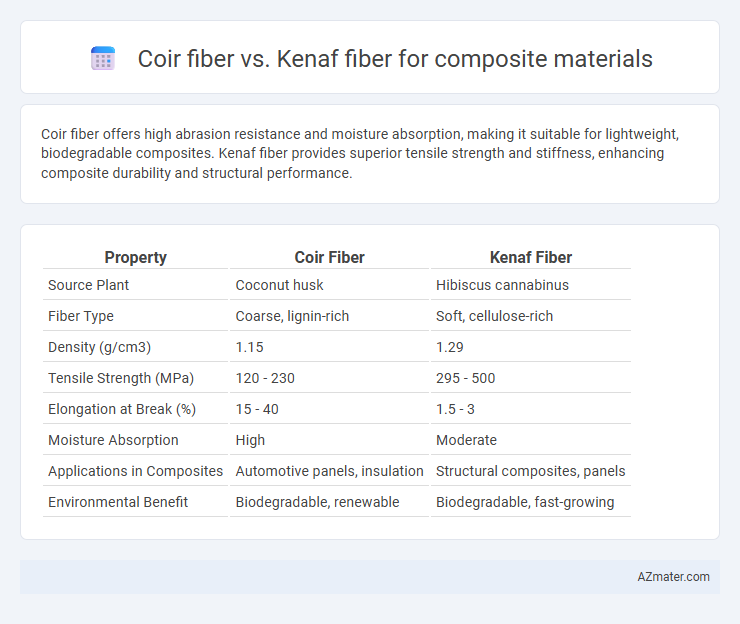Coir fiber offers high abrasion resistance and moisture absorption, making it suitable for lightweight, biodegradable composites. Kenaf fiber provides superior tensile strength and stiffness, enhancing composite durability and structural performance.
Table of Comparison
| Property | Coir Fiber | Kenaf Fiber |
|---|---|---|
| Source Plant | Coconut husk | Hibiscus cannabinus |
| Fiber Type | Coarse, lignin-rich | Soft, cellulose-rich |
| Density (g/cm3) | 1.15 | 1.29 |
| Tensile Strength (MPa) | 120 - 230 | 295 - 500 |
| Elongation at Break (%) | 15 - 40 | 1.5 - 3 |
| Moisture Absorption | High | Moderate |
| Applications in Composites | Automotive panels, insulation | Structural composites, panels |
| Environmental Benefit | Biodegradable, renewable | Biodegradable, fast-growing |
Introduction to Natural Fibers in Composites
Coir fiber, extracted from coconut husks, offers high lignin content which provides enhanced durability and water resistance in composite materials, making it ideal for applications requiring moisture tolerance. Kenaf fiber, derived from the Hibiscus cannabinus plant, is valued for its high tensile strength and lightweight properties, contributing to improved mechanical performance and sustainability in composites. Both fibers serve as eco-friendly reinforcements in natural fiber composites, promoting biodegradability and reducing reliance on synthetic materials.
Overview of Coir Fiber: Properties and Sources
Coir fiber, derived from the outer husk of coconut shells, is a natural lignocellulosic fiber characterized by high durability, low density (1.15 g/cm3), and excellent resistance to saltwater and microbial degradation. Its high lignin content (40-45%) imparts rigidity and resilience, making it suitable for composite materials requiring impact resistance and cushioning properties. Predominantly sourced from coconut-producing regions such as India, Sri Lanka, and the Philippines, coir fibers support sustainable and biodegradable composite applications in automotive and construction industries.
Overview of Kenaf Fiber: Properties and Sources
Kenaf fiber, derived from the Hibiscus cannabinus plant, is a natural bast fiber known for its high tensile strength, lightweight, and excellent biodegradability, making it ideal for composite materials. With a fiber density of approximately 1.4 g/cm3 and cellulose content around 45-57%, kenaf offers superior mechanical properties and moisture absorption compared to coir fiber. Predominantly cultivated in tropical regions such as India, Bangladesh, and parts of Africa, kenaf's rapid growth cycle and renewable nature contribute to its sustainability as a composite reinforcement material.
Mechanical Properties Comparison: Coir vs Kenaf
Kenaf fiber exhibits higher tensile strength and modulus compared to coir fiber, making it more suitable for applications requiring stiffness and load-bearing capacity in composite materials. Coir fiber, with its higher elongation at break and impact resistance, offers superior energy absorption and flexibility, advantageous for composites subject to dynamic stresses. Both fibers have distinct mechanical properties that influence the performance of composites, with kenaf providing enhanced structural integrity while coir delivers better toughness.
Thermal Stability and Resistance: Coir vs Kenaf
Coir fiber exhibits superior thermal stability with a higher degradation temperature around 280degC, making it more suitable for composite materials exposed to elevated heat compared to kenaf fiber, which begins degrading near 220degC. Resistance to thermal decomposition in coir is attributed to its high lignin content, enhancing durability in high-temperature applications, whereas kenaf's lower lignin and higher cellulose content reduce its thermal resistance. Coir-based composites maintain structural integrity better under thermal stress, positioning coir as a preferred choice for composites requiring enhanced heat resistance.
Environmental Impact and Sustainability
Coir fiber and Kenaf fiber present distinct environmental impacts and sustainability profiles for composite materials; Coir fiber is a natural byproduct of coconut husks, promoting waste valorization and reducing agricultural residue disposal challenges, while offering high biodegradability and low carbon footprint. Kenaf fiber, derived from fast-growing Hibiscus cannabinus plants, supports sustainable agriculture through rapid biomass regeneration, high yield per hectare, and effective carbon sequestration, making it an eco-friendly reinforcement in composites. Both fibers reduce reliance on synthetic fibers, but Kenaf's agricultural benefits and Coir's waste utilization emphasize their complementary roles in advancing green composite materials.
Processing and Compatibility with Polymer Matrices
Coir fiber exhibits high lignin content, leading to rough surface morphology that enhances mechanical interlocking but requires surface treatments like alkali or silane to improve adhesion with hydrophobic polymer matrices. Kenaf fiber, characterized by lower lignin and higher cellulose content, offers smoother surfaces and better inherent compatibility with thermoplastic and thermoset matrices, facilitating easier processing and stronger fiber-matrix bonding. Processing of coir fiber demands thorough cleaning and chemical modifications to reduce moisture absorption and improve interface strength, while kenaf fiber integrates more readily into composite formulations with minimal treatment, resulting in improved mechanical properties and durability.
Cost-Effectiveness and Market Availability
Coir fiber offers a highly cost-effective solution for composite materials due to its abundant availability in tropical regions and low production costs, making it ideal for budget-sensitive applications. Kenaf fiber, while slightly more expensive, provides superior mechanical properties and consistent quality, which enhances the performance of composites in automotive and construction industries. Market availability of coir is significantly higher in countries like India and Sri Lanka, whereas kenaf cultivation is expanding in the United States and Southeast Asia, influencing regional material selection based on supply chain stability.
Applications in Composite Materials
Coir fiber, derived from coconut husks, offers high abrasion resistance and durability, making it ideal for automotive interior panels and insulation composites. Kenaf fiber, obtained from the hibiscus plant, provides superior tensile strength and lightweight properties, widely used in structural composites and eco-friendly construction materials. Both fibers enhance biodegradability and mechanical performance in composite applications, with coir suited for impact resistance and kenaf for load-bearing components.
Conclusion: Selecting the Optimal Fiber for Composites
Coir fiber offers excellent durability and water resistance, making it suitable for composites requiring high toughness and environmental resilience. Kenaf fiber provides superior tensile strength and lightweight properties, ideal for applications demanding enhanced mechanical performance and reduced weight. Choosing between coir and kenaf fibers depends on application-specific requirements, with coir favored for impact resistance and kenaf preferred for structural strength in composite materials.

Infographic: Coir fiber vs Kenaf fiber for Composite material
 azmater.com
azmater.com